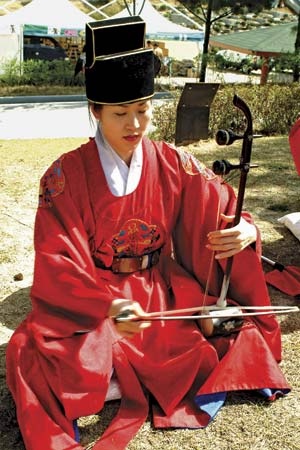haegŭm
musical instrument
also spelled haegeum or haekeum
 two-stringed vertical fiddle used in many traditional Korean musical genres. A hardwood bow strung with horsehair is passed between the strings to create the sound. The soundbox is made of paulownia wood and is open at the back. The two twisted-silk strings, tuned a fifth apart (as c-g), are attached at the bottom of the soundbox; they pass over a small wooden bridge and up the long bamboo neck to large pegs.
two-stringed vertical fiddle used in many traditional Korean musical genres. A hardwood bow strung with horsehair is passed between the strings to create the sound. The soundbox is made of paulownia wood and is open at the back. The two twisted-silk strings, tuned a fifth apart (as c-g), are attached at the bottom of the soundbox; they pass over a small wooden bridge and up the long bamboo neck to large pegs.In performance the musician sits cross-legged, holding the instrument vertically on the left knee. The left hand controls pitch and vibrato by pulling the strings toward the neck; there is no fingerboard. With the right hand the performer moves the bow horizontally between the strings while controlling the tension of the horsehair.
The haegŭm was introduced to Korea from China during the Koryŏ period (918–1392); it may have originated in Mongolia. Its Chinese counterpart is the erhu. The versatility and range of the instrument make it suitable for a number of genres, including the traditional Korean court music of both the Chinese-derived (t'ang-ak) and the Korean (hyang-ak) styles (in which it is paired with the ajaeng), folk and shaman ensembles, and the solo virtuoso sanjo music. Modern forms of the haegŭm have been developed that more closely resemble the instruments of the Western violin family.
- Fitzsimmons, Robert
- Fitzsimmons, Sunny Jim
- Fitzthedmar, Arnold
- Fitzwalter, Robert
- Fitzwilliam Museum
- Fiume question
- Five Dynasties
- Five Good Emperors
- Five Great Kings
- five hundred
- Five hundred scores
- Five Pecks of Rice
- Five-Power Constitution
- fives
- Five, The
- fixed-point theorem
- Fizeau, Armand-Hippolyte-Louis
- fjord
- Flacius Illyricus, Matthias
- flag
- flagbird
- Flag Day
- flagellate
- flagellation
- flagellum